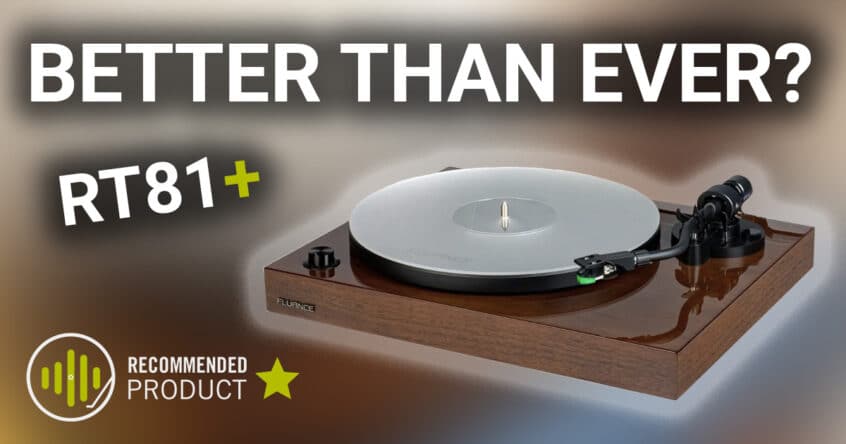Canadian-based audio brand Fluance has earned a reputation for packing unbelievable value into its products. In particular, the RT81 brought exceptional value to anyone seeking to kickstart their vinyl hobby or jump back in after re-discovering a long-lost record collection.
The RT81+ adds an acrylic platter mat, adjustable feet, and Audio Technica’s new AT-VM95E cartridge to Fluance’s popular affordable turntable offering.
Could the RT81+ be the best-value entry-level turntable on the market?
RT81+ Upgrades
Most significant of all is the adjustable feet. For a turntable to track the record grooves accurately, it has to be level. The new RT81+ features three height-adjustable rubber feet, which, using the spirit bubble provided, you can tweak as required.
Unlike the original RT81, the feet are also a “spike” design, which helps to minimize surface contact and further reduce unwanted vibrations. This is a hugely welcome upgrade – particularly as someone who lives in an older home with a suspended wooden floor.
Even with the kids running and jumping around in my living room, the RT81 remained untroubled by what can sometimes feel like a herd of elephants stampeding through the living room!
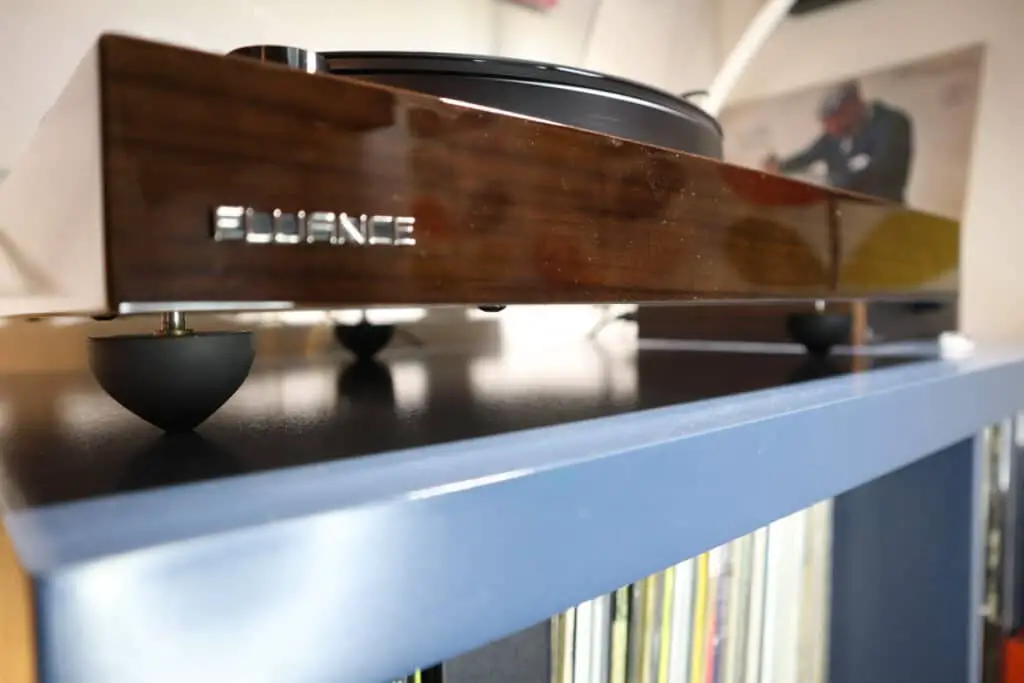
The ability of the RT81+ to handle unwanted vibrations is helped further by the solidity of its plinth, which is made from a high-density solid MDF.
On top of this is a dampened aluminum platter and the welcome addition of an acrylic platter mat in place of the old rubber mat.
Acrylic platters are a popular option for turntables as they’re not only very low resonance, but the material is also virtually the same as a vinyl record.
This creates a “coupling” effect that, in theory, makes it easier for the vibrations caused by the stylus tracking the groove to defuse away from the record surface.
So, while a full acrylic platter is perhaps unachievable at this price point, the addition of an acrylic mat gets us some of the way there.
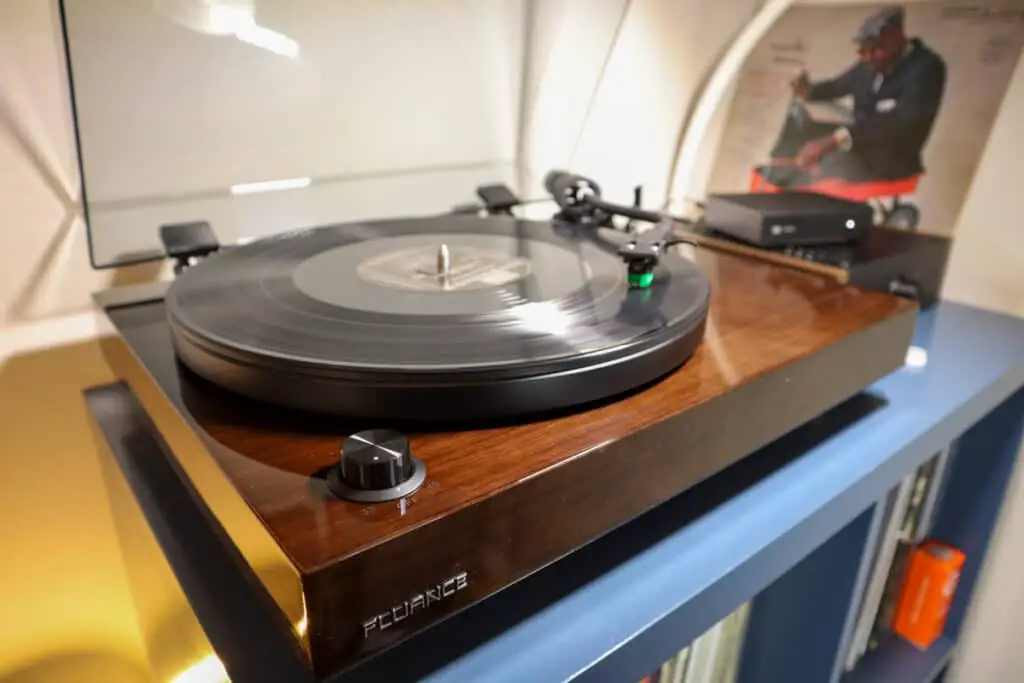
Upgradable Cartridge Eco-System
The RT81+ comes pre-fitted with the new Audio Technica AT-VM95E, which replaces the now-discontinued AT-95E.
Audio Technica have greatly improved the mounting design of the cartridge by re-designing the body with two threaded mounting screws. This means it can be mounted to any standard headshell or tonearm using just two screws – no more bolts required!
Not that you’ll have to worry about this when setting up your new RT81+, as the AT-VM95E comes pre-aligned and mounted to the headshell right out of the box.
A huge selling point of the new VM95 series, though, is the upgradable stylus eco-system.
There are six models in the VM95 series, all using the same cartridge body, meaning you can easily swap out the stylus for a quick audio upgrade.
The supplied VM-95E has an elliptical stylus, but you could easily and quickly upgrade that to a nude-elliptical, micro-linear or Shibata stylus should the mood take you.
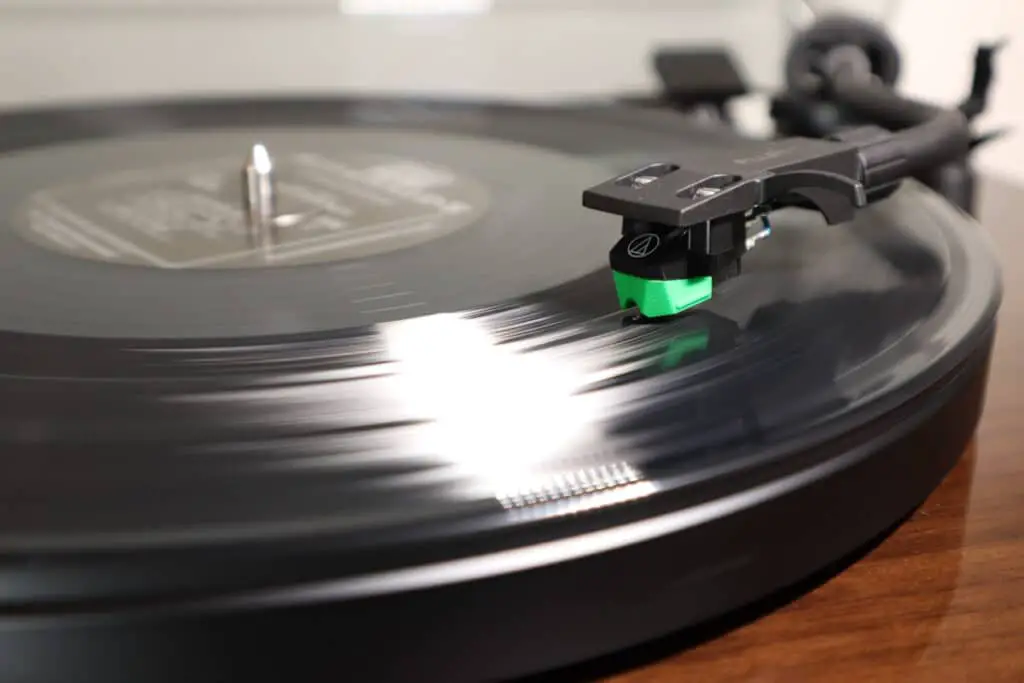
Also of note…
Fluance have retained the built-in Texas Instruments phono stage on the RT81+, which you can switch off when the time comes to upgrade to an external phono preamp.
Lastly, the RT81+ also features a very handy auto-stop function that automatically stops the turntable spinning after a few rotations in the run-out groove.
This can help increase the life of your stylus if you have a tendency to fall asleep after a late-night listening session, leaving the stylus to spin endlessly in the dead wax!
Not a fan of auto stop? No worries – simply switch it off at the rear panel.
Fluance RT81+ Review – First Impressions
The first thing that struck me about the RT81+ was just how solid it feels for a turntable costing just $300.
I’m used to seeing plinths this solid on decks costing much, much more, and at this price, the weight and feel of the RT81+ feels miles ahead of its competitors.
Take the Pro-Ject E1, for example, which is another entry-level turntable I recommend costing $350. While the E1 does produce a great sound, one of my criticisms was the extremely lightweight design.
Unlike the RT81+, the E1 swaps the solid MDF plinth for a composite fiber alternative and a hollow ABS polymer platter on top. Both of which are incredibly light, and while they do a good job of controlling resonance, it does make the overall deck feel much more flimsy.
There are pros and cons to any design, of course, and Pro-Ject have a very different ethos when it comes to designing turntables. For example, Pro-Ject are adamant that a one-piece tonearm is key to audiophile-level vinyl playback.
In contrast, Fluance turntables favor s-shaped tonearms with mountable headshells for easy cartridge swapping.
Ideology aside, out of the two, the RT81+ certainly feels higher-end and exerts a sense of quality that feels well above its price tag.
The speed control button particularly impressed me. It’s a robust design and feels more luxurious to use than the controls on either my Technics SL1500c or Pro-Ject X1. Impressive, given the vast price difference!
The tonearm does feel less solid than a Technics arm, but by no means in a way that makes it feel cheap.
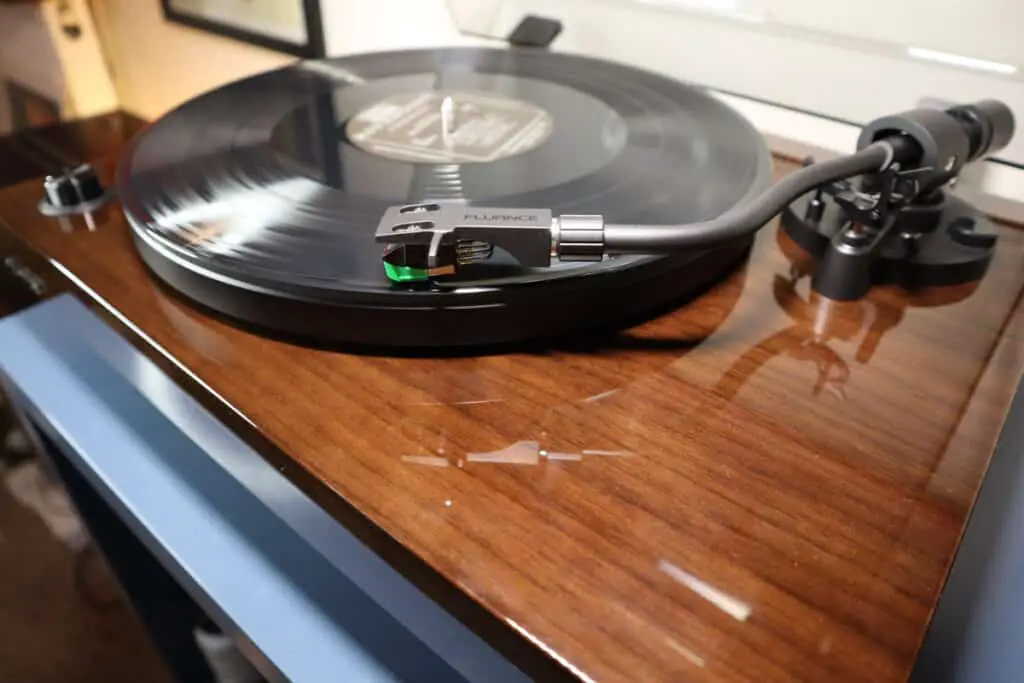
Fluance RT81+ Listening Test
The supplied phono cartridge usually carries the overall sound signature of a turntable setup.
Audio Technica’s VM-95E has superb authority in the low end but is much more reserved in the high-frequencies compared to my usual Ortofon 2M Red or 2M Blue models.
Some may find this a little more balanced, as the Ortofon cartridges have a reputation for producing extended, dynamic high-frequencies.
If you think the more forward sound of a 2M Red could be your thing, then you can always mount one to a second headshell and run comparisons to see which one you prefer.
In many cases, the warmer, more reserved quality of the VM-95E might suit your setup better. For example, hooking the RT81+ into the Schiit Mani 2 phono preamplifier, which to my ear, sounds more forward in the up-mid and high-frequencies, helped to extend the otherwise quite restrained top-end of the VM-95E.
The built-in phono stage on the RT81+ sounds just as competent as the built-in phono preamp on my integrated amplifier, making it a great option for anyone just starting out.
Referencing the RT81+ with VMP’s recent re-issue of Thin Lizzy’s Jailbreak, I was impressed by the overall weight of the sound.
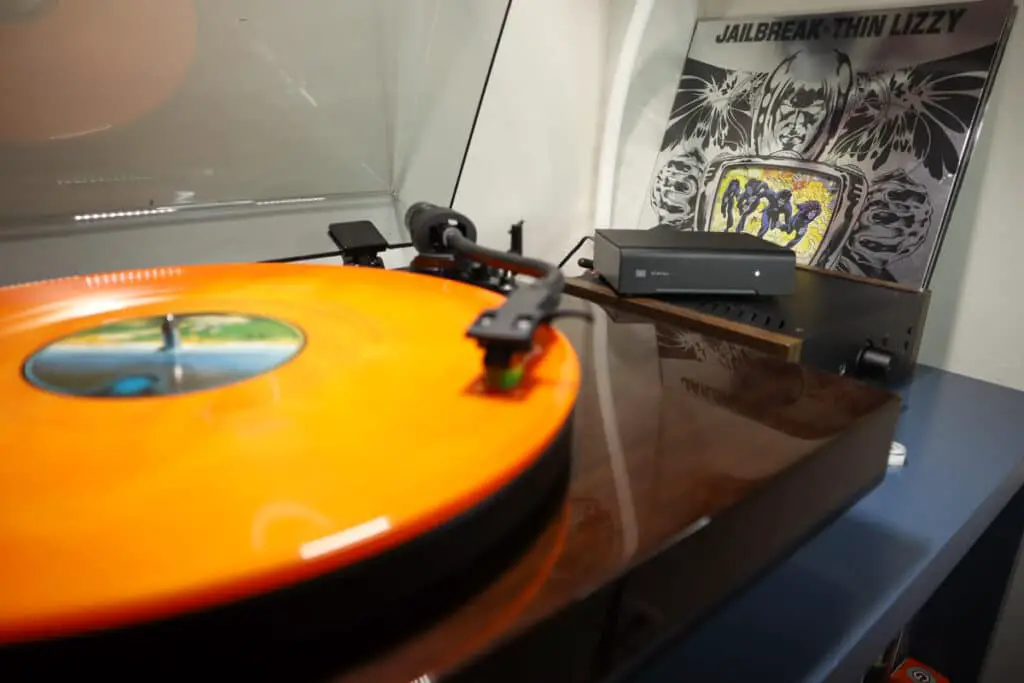
“Weight”, in audio terms, can often lead to a muddy sound, but not in this instance, as the RT81+ manages to retain an alluring level of punch and clarity.
This quality is heightened further when paired with a great external phono stage, the Mani 2 mentioned earlier being a great fit at this price point.
In doing so, the high frequencies open up, and the low end becomes more focused and rhythmic. Dynamics, in general, become more pronounced, and instrument separation (particularly in the mid-range) sound more refined.
Compared with Pro-Ject’s entry-level offerings, the RT81+ is less nimble on its feet, and less agile – particularly in the high frequencies. That said, the Pro-Ject models simply can’t compete when it comes to the sheer weight of sound on offer here.
Fluance RT81+ – The Bottom Line
The Fluance RT81+ is an unbelievably well-built turntable for the price in what is an increasingly competitive market.
Fluance has a distinct advantage here: it operates a direct-to-consumer model, as opposed to the more traditional distributor and dealers model.
With more traditional distribution models, it can make producing a deck this solid at such an affordable price challenging at best.
Not only is the plinth one of the most solid of any budget deck below the $500 mark, but the wood veneer finish is also remarkably convincing, making the RT81+ not only sonically compelling, but also beautiful.
Add in adjustable feet and the inclusion of an acrylic platter mat, and I begin to wonder how Fluance makes any money whatsoever!
Some of the Pro-Ject and Rega models I’ve heard at this price may have more agility, finesse, and reach at the higher frequencies, but they can’t touch the weight and strength of the RT81+.
As mentioned, pair the RT81+ with the right phono preamp, and you can help extend the reach and air.
Is this the best budget turntable money can buy? Well, it’s certainly hard to see another competitor at this price quite getting the balance between sound quality, usability and durability quite so spot on!
One final consideration before you press the buy button: do you really need the internal phono preamp? If, in your case, you don’t, it’s worth considering if the Fluance RT82 might suit your needs better.
From the RT82 up in the Fluance range, the motor gets a significant upgrade and is isolated from the platter. It also becomes very easy to upgrade the platter from the stock aluminum version to acrylic. Food for thought, as the base RT82 currently costs exactly the same as the RT81+.
VIEW PRODUCT
Further Reading:
Best budget turntables






